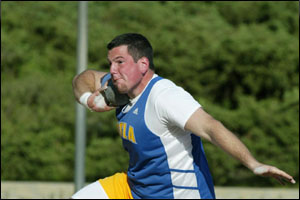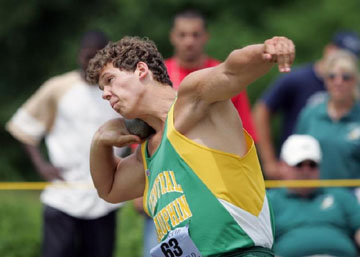VOLUME
8
ISSUE
3
JANUARY , 2006
LETTER FROM THE EDITOR
Striking Up An Alliance
DOMINANT
Ryan Vierra could be the best Highland athlete ever
FAST TRACK TO THE TOP
Gerd Kanter’s rise up the disc ladder has been swift
SPACE FOR RENT
Adam Nelson chronicles his 2005 season
TRAINING THE CORE
Hitting it from all angles
NO REGRETS
Steve Backley reflects
GONE TOO SOON
The life and times of Terry Albritton
THINKING OUTSIDE THE BOX
Why not the spin shot for preps?
PAVEL-MANIA!
Kettlebells, Stretching and Performance
ARCH LIKE A PRO
Pavel examines the squat stance
DUTCH TREAT
Talking with the Netherlands national coach Gert Damkat
THE OUTSIDER
There’s a new face in the women’s shot
A MASTERFUL THROWER
George Mathews love for the hammer
TALKIN’ HAMMER
Mohamad Sataara’s practical approach to the ball and wire
WARM-UP STRATEGIES
Proper preparation for performance
NATIONAL THROWS COACHES ASSOCIATION
Looking To The Future
In A Class Of Their Own
Elite Athlete Summit
Must Be The ShoesMasters, Friends and Family
Completing The Circle
Transitioning Back To Coaching
Fighting For The Last Quarter
Inch
It’s a physics thing
ROTATIONAL
SHOT FOR PREPS
THINKING OUTSIDE THE BOX
By Glenn Thompson, with Dr. Robert Silverman
One of the worst responses a middle manager can give his boss is, "Because that’s the way we’ve always done it." Spit that one out and you’ll be the first one out the door during the next corporate ‘rightsizing’.
There’s some of that approach to high school throwing. At the average school, shot/discus throwers learn the glide in the shot and standard discus technique. Why? Just because that’s the way it is, period.
But why not the spin? "We don’t have anyone here who knows how to coach that style."
Huh?. Really? Well guess what? If you can’t teach the rotational shot, then you sure as hell can’t teach the discus. It’s that simple! There’s a popular misconception that teaching the rotational shot takes a Masters sheepskin in kinesiology and perhaps a visit to a Tibetan temple to understand the mysterious metaphysical aspects of the movement.
In fact, if you give it about five seconds of thought, you’ll realize that the two movements are much more alike than they are dissimilar. The footwork is virtually identical, the tempo is slow to fast for both, and they both reward athleticism.
So why not indirectly teach one event while working on the other? Why not reinforce the same nervous pattern in one event while teaching the other?
This concept first came to me last spring when my friend, Dr. Robert Silverman, took his coaching skills from his hometown high school (Annville-Cleona, PA) to nearby Palmyra. Doc told me one day early last spring he was moving to the spin as his standard method. That’s a groundbreaking move in these parts, where decent technique of any sort is relatively rare. Doc has never been afraid to break new ground, and such a move was true to his nature.
I would argue that in terms of distance, there’s more upside with the rotation for the typical athlete who doesn’t bench press 400 pounds or have a 8’ wingspan. And I would further argue that a reliable rotational technique can be put together in no more time than it takes kids to figure out the glide.
 |
| Jeremy Silverman |
Unlike the football and basketball teams, there’s no off-season conditioning or summer league hoops for most prep throwers. Your athletes don’t toss the shot in a fall league. Odds are that at most any school, 90% of the throwers last picked up an implement when their season ended last spring. And maybe half of the kids have never touched an implement before. Your lucky if 50% of them have even lifted a weight. So how do we make the best use of the two-plus months you have with these "recreational" throwers?
Teach them one technique, not two!
Now is this an anti-O’Brien style editorial? ABSOLUTELY NOT. There’s a lot of old school coaches out there who swear by the glide and feel it is the most reliable technique. To make these statements represents a form of heresy or libel against their favored technique.
I am by no means bashing the glide. It has been a very effective style for over fifty years now, and will continue to be just that for those best suited to it. But I have a vision of high school track meets where the glide becomes the novel technique. A vision where both the shot and discus are hurled with similar techniques that breed improved performance.
*********************************************
I asked Dr. Silverman to reflect on his experience importing the rotational shot to a new school in 2005.
Certainly, the fact that my knowledge and experience in teaching the glide technique is limited contributed to my decision to teach only the rotational. However, I found that using one technique:
1. Reduces the confusion for the students,
2. Makes it much easier to teach a larger number of student-athletes
3. Does not give the early frustrated thrower an "al- ternative" style to retreat into – prep throwers perceive the glide as easy and less complicated and if both styles were available, in times of difficulty would want change to the glide.
4. Athletes are all on "the same page" and better equipped to help out a teammate
5. Makes practices easier to organize
I allowed a few of my throwers at Annville Cleona to glide because I felt these prep throwers did not have the athleticism, coordination or mental capacity to spin. I was right, but that also proved true for them in the glide. The fact that they were gliding became big distraction to my spinners when I first took over the program. As in any program there are athletes that pick up the technique very fast and with others it becomes a struggle. Making them focus on this one technique makes it easier for me to transition into discus.
Having an experienced rotational thrower on the team or at practice on a regular schedule definitely helps the prep thrower with visualization of the whole process.
I found that videotaping is a must at the beginning to help the students "see themselves" as rotational throwers (besides the obvious training benefits). I tape practices and at the end of the week give them each copies on CD. I also taped each meet, reviewed it with them as a group, and then sent them home with a copy to study in slow motion. I would give them a "pop quiz" while working out the next day on their mistakes and ask them what THEY would do to correct them.
I found that if you are not ready to give the young athletes the support needed at first, you might as well go back to the glide, where you can just scream out your instructions. In young athletes that are still trying to find out who and what they are about, the concepts of balance out of the back, hitting three o’clock, blocking and screaming can become at first overwhelming. My first conversation with the kids always begins with a disclaimer – This will be frustrating to many of you at first, BUT once you start to master the spin, you’ll put the gliders to shame. This same message was given repeatedly thoughout the season until one day it’s no longer needed.
 |
| Ryan Whiting |
Of course having locals Jeremy Silverman [former state shot record holder (H.S. PR- 65’4") and shot/disc champion, U.S. Junior silver medallist, now at UCLA] and Ryan Whiting [ 70’0", 2005 U.S. #1 prep ranked in the shot and disc, Pan-Am Junior SP/DT gold, now at Arizona State) as role models doesn’t hurt either!
The students at Palmyra were very receptive to the idea of everyone spinning, and the parents – whom I worried about the most – gave me no grief at all.
One reason the first year was relatively uneventful was that we had no upperclassmen on the throwing squad. That meant there were no gliders that had any successes with that technique and had to be changed. The girls seemed to be more problematic than the guys on hitting positions and getting their hips into place. They all enjoyed and still love the attention they receive at meets when the whole team is spinning (even though that’s all that some of them are doing).
I feel that making the rotational shot standard at this school has made coaching easier, and easier for the athletes to learn. Rotation, unlike the glide, is a concept more than a technique, and I tell the students that it will come to them in pieces that will all come together. We are at that point this second year in the program – time to get strong and tweak and tweak and tweak.
The first year we had a fair amount of success with the boys and girls teams. We were scoring points for the team and starting moving to our goals. All but one of the students were able to compete using some level of confidence using the rotational technique by the end of the season. We had only lost one student to the frustration of learning the technique – a football player who had some misconception about what was involved in putting the shot, and a serious lack of coordination.
Successful programs always bring out more students, and as it did at Annville – there the throwers supplied the winning points every meet. Who knows how many more like Jeremy and Ryan are on the horizon? *LSTJ*